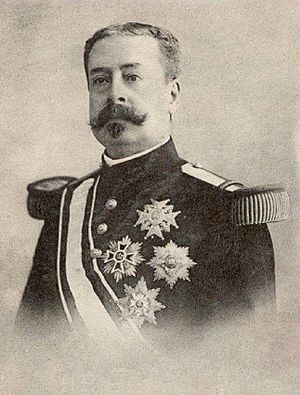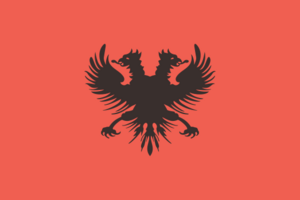Juan Pedro Aladro Kastriota facts for kids
Quick facts for kids
Juan Pedro Aladro y Kastriota
|
|
|---|---|
 |
|
| Born |
Juan de Aladro de Perez y Valasco
5 August 1845 Jerez de la Frontera, Andalusia, Spain
|
| Died | 15 February 1914 (aged 68) Paris, France
|
| Nationality | Spanish |
| Other names | Aladro Kastrioti |
| Occupation | Diplomat |
| Known for | Pretender of Albanian Crown |
| Spouse(s) | Juana Renesse y Maelcamp |
| Signature | |
Juan Pedro Aladro y Kastriota (1845–1914) was a Spanish nobleman and diplomat. He was also known as Aladro Kastrioti by Albanians. He wanted to become the king of Albania. He believed he was related to the Kastrioti family, a famous Albanian noble family. People often called him Don Aladro.
Contents
Early Life and Diplomatic Career
Juan Pedro Aladro was born in 1845 in Jerez de la Frontera, a city in Andalusia, Spain. He went to school in his hometown until 1862. After that, he studied law in Sevilla.
In 1867, he started working as a diplomat for Spain. A diplomat is someone who represents their country in other nations. He worked in many European cities, including Vienna, Paris, Brussels, The Hague, and Bucharest. He became very successful in his career during the time of King Alfonso XII.
After King Alfonso XII died, Juan Pedro Aladro moved to Paris. He lived there using money from the winery businesses his father left him. He was also known as a sportsman and owned many racing horses.
Supporting the Albanian Cause
During his time as a diplomat, Juan Pedro Aladro became very interested in the idea of an independent Albania. He started publishing small books and papers about Albania all over Europe. He sent these to cities like Brussels, Alexandria, Athens, and Venice.
He also helped financially. He gave money to the First Albanian School of Korçë. This help allowed the school to stay open until the Ottoman authorities closed it.
Don Aladro kept in touch with Albanian leaders and thinkers, known as Rilindas. Some of them saw him as the right person to be king of a future independent Albania. He visited Sicily and Calabria to meet with Arbëreshë leaders. These were people of Albanian descent living in Italy. He wanted their support for his goal. He even visited the Montecassino Abbey to find old documents that might prove his link to the Kastrioti family.
Actions Towards the Throne
Around 1900, Don Aladro began to take more direct steps to become king. He created a special prize for writers. In 1901, a Catholic priest named Ndoc Nikaj won this prize. In 1902, he helped fund an Albanian student club in Bucharest called Shpresa, which means "The Hope."
That same year, he worked with Faik Konica to publish a map of Albania in Brussels. He also gave money to the La Nazione Albanese newspaper. This newspaper was run by an Arbëreshë writer named Anselmo Lorecchio, who, in turn, promoted Don Aladro.
Don Aladro also sent a person named Visko Babatasi to Albania. Babatasi's job was to give out money, revolvers, and postcards with Aladro's picture and the Albanian flag. This was to promote Aladro's name among Albanians. The Ottoman authorities eventually stopped the postcards because they were too obvious. Many of these postcards still exist today.
It was said that the Ottomans offered Aladro important positions in Albania to stop him. But Aladro asked for full freedom for all of Albania, which the Ottomans refused.
The Albanian Flag Connection
According to Eqrem Vlora, a well-known Albanian politician, the Albanian flag raised during the Albanian Declaration of Independence in Vlorë on November 28, 1912, was a gift from Don Aladro. He had given it to Vlora in 1909.
The official Albanian story says that Marigo Posio sewed the flag herself. Eqrem Vlora confirmed that the organizers of the event asked him for the flag. He then gave it to Posio so she could make copies.
Later Life and Legacy
In 1913, the Albanian Congress of Trieste was held. This meeting discussed who would be the future prince of Albania. Aladro was one of the people considered, and he had some support. However, the powerful European countries did not want a Catholic ruler for Albania. They worried about how different religious groups in Albania would react. They also thought Aladro was too new to the idea of ruling.
Aladro stayed in Paris, where he managed a railway company. He passed away in a hotel in Paris in 1914.
Juan Pedro Aladro was a very generous person. He could speak many languages, including French, Italian, English, German, Spanish, Russian, Albanian, and Basque. People in Spain saw him as a "perfect gentleman, a devoted Christian, a wonderful son, and someone who loved art."
He also wrote for a Basque newspaper called Euskal Erria. He always ended his articles with the phrase: Euskalerria aurrera! Shkiperia perpara! This means "Forward Euskal Erria! Forward Albania!" Besides Albania, he also supported the Basque cause. He believed some of his ancestors came from the Basque region of Bidania. He wrote a short story in French called Sotir y Mitka, which was published in Spanish in 1912.
In 1912, Juan Pedro Aladro married Juana Renesse y Maelcamp, a Belgian countess. She had been married before. Aladro did not have any children. After his death, his wife went to Spain to settle his inheritance. She died shortly after.
Flag of Aladro Kastriota
A document from the Ottoman archives from 1902 shows a picture of Juan Pedro Aladro Kastriota. Next to him is a version of the Albanian flag. These pictures were found with an Albanian calendar. Two people, Nuri Frashëri and Basco Barbatassi, tried to give them out across the Ottoman Empire.
Honours
Juan Pedro Aladro received several important awards, including:
- Knight of the Order of the Holy Sepulchre
- Knight Grand Cross of Order of Isabella the Catholic
- Commander of the Order of Charles III
- Grand Cross of Order of the Star of Romania
- Grand Cross of Order of St Alexander of Bulgaria
See also
 In Spanish: Juan Pedro Aladro y Kastriota para niños
In Spanish: Juan Pedro Aladro y Kastriota para niños


